
国家中心与巴基斯坦农业委员会Syed A. Rizvi博士合作,对藏药“恰羔贝”的研究成果“Two alkaloids from Delphinium brunonianum Royle, their anti-inflammatory and anti-oxidative stress activity via NF-κB signaling pathway”发表在中科院TOP 1区期刊Frontiers in Nutrition(IF6.576)。
囊距翠雀花(Delphinium brunonianum Royle)为毛茛科翠雀属多年生草本植物,生于海拔4500~6000 m 的草地或多石处,在我国主要分布于西藏南部,在巴基斯坦、尼泊尔及阿富汗也有分布。其化学成分主要包括生物碱、黄酮等。作为一种民间用药,囊距翠雀花干燥的地上部分通常具有清热、解毒、消炎、镇痛的药理作用。但其抗炎活性成分和作用机制尚不清楚,因此本研究对提取分离得到的几种化合物进行抗炎活性筛选,并进一步展开对其抗炎机制的研究。
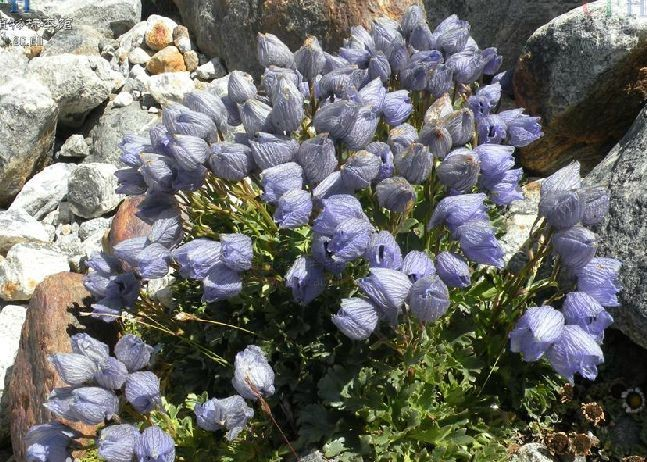
炎症的发生与发展
炎症是许多病理过程的基础。感染和组织损伤是引起炎症的主要原因,它们招募白细胞和血红蛋白向病变组织转移。巨噬细胞在炎症的发生发展过程中发挥重要作用。巨噬细胞的两项基本功能是吞噬和适应性免疫应答。吞噬作用在机体对急性炎症的反应中起着至关重要的作用,它能迅速抵抗外来病原体的入侵清并除凋亡细胞。巨噬细胞还可以与树突状细胞一起呈递抗原。同时巨噬细胞还能分泌多种强大的炎症因子,如肿瘤坏死因子、白介素等。因此,选取巨噬细胞RAW264.7作为本研究的实验模型。
研究方法
本研究从囊距翠雀花干燥的地上部分用乙醇提取分离得到了4个化合物,包括Delbrunine (1), 4-O-α-D-Glucosyl benzoic acid (2), Kaempferol 3-O-β-D-glucopyranoside 7-O-α-L-rhamnopyranoside (3), Eldeline (4)。我们利用RAW264.7细胞对其进行了抗炎活性筛选,结果表明化合物1和化合物4具有较好的的抗炎效果。因此我们通过Western blot实验和PCR实验进一步阐明它们的抗炎作用机制,为囊距翠雀花植物开发新型抗炎药物提供依据。
化合物结构鉴定结果
Delbrunine (1), 4-O-α-D-Glucosyl benzoic acid (2), Kaempferol 3-O-β-D-glucopyranoside 7-O-α-L-rhamnopyranoside (3), Eldeline (4).
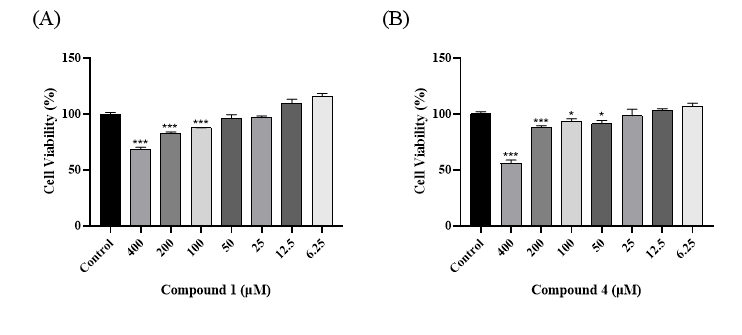
FIGURE 1 | Structures of compounds 1-4 from D. brunonianum
抗炎活性实验结果:
本研究通过LPS建立RAW264.7巨噬细胞炎症模型,通过NO和ELISA试剂盒检测发现,化合物1和化合物4能显著抑制NO、IL-6和TNF-α的分泌。PCR结果显示,化合物1和化合物4也可显著抑制相应mRNA的表达。Western blot结果显示,其通过抑制NF-κB信号通路激活发挥抗炎作用,同时显著降低了iNOS、COX2蛋白的表达。ROS的产生与炎症密切相关,流式细胞术结果显示,这两种化合物均能够抑制ROS的产生。
MTT实验

FIGURE 2 | Effects of compound 1 (A), compound 4 (B) on the viability of RAW264.7 cells. The data were expressed as mean ± standard deviation, n = 6. ***P < 0.001, *P < 0.05 compared with the control group.
NO的检测及iNOS的mRNA表达
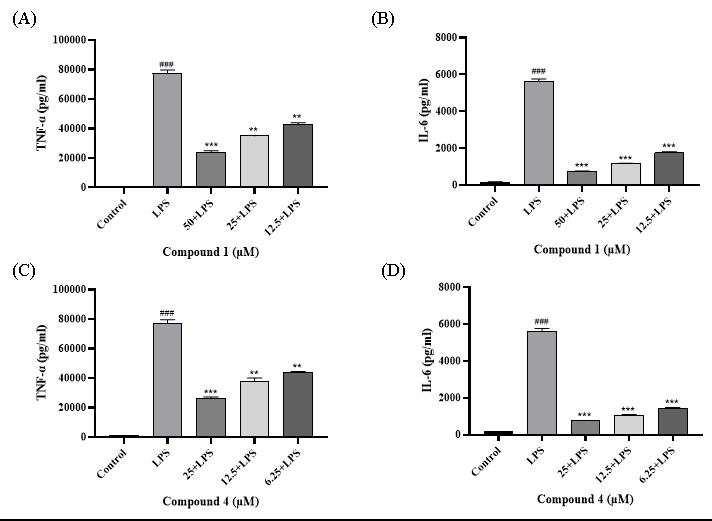
FIGURE 3 | Effects of compound 1 (A), compound 4 (B) on NO production and effects of compound 1 (C), compound 4 (D) on iNOS mRNA expression in RAW264.7 cells. The data were expressed as mean ± standard deviation, n = 3. Compared with the control, ###P < 0.001. Compared with the LPS group, ***P < 0.001, **P < 0.01, *P < 0.05.
TNF-α, IL-6的检测

FIGURE 4 | Effects of compound 1 (A), (B) and compound 4 (C), (D) on the secretion of TNF-α, IL-6 in LPS-Induced RAW264.7 Cells. The data were expressed as mean ± standard deviation, n = 3. Compared with the control, ###P < 0.001. Compared with the LPS group, ***P < 0.001, **P < 0.01.
TNF-α, IL-6mRNA的表达

FIGURE 5 | Effects of compound 1 (A), (B) and compound 4 (C), (D) on the expression of TNF-α, IL-6 mRNA in LPS-Induced RAW264.7 cells. The data were expressed as mean ± standard deviation, n = 3. Compared with the control, ###P < 0.001. Compared with the LPS group, ***P < 0.001, **P < 0.01.
化合物1和化合物4对LPS诱导的iNOS和COX-2蛋白表达的影响
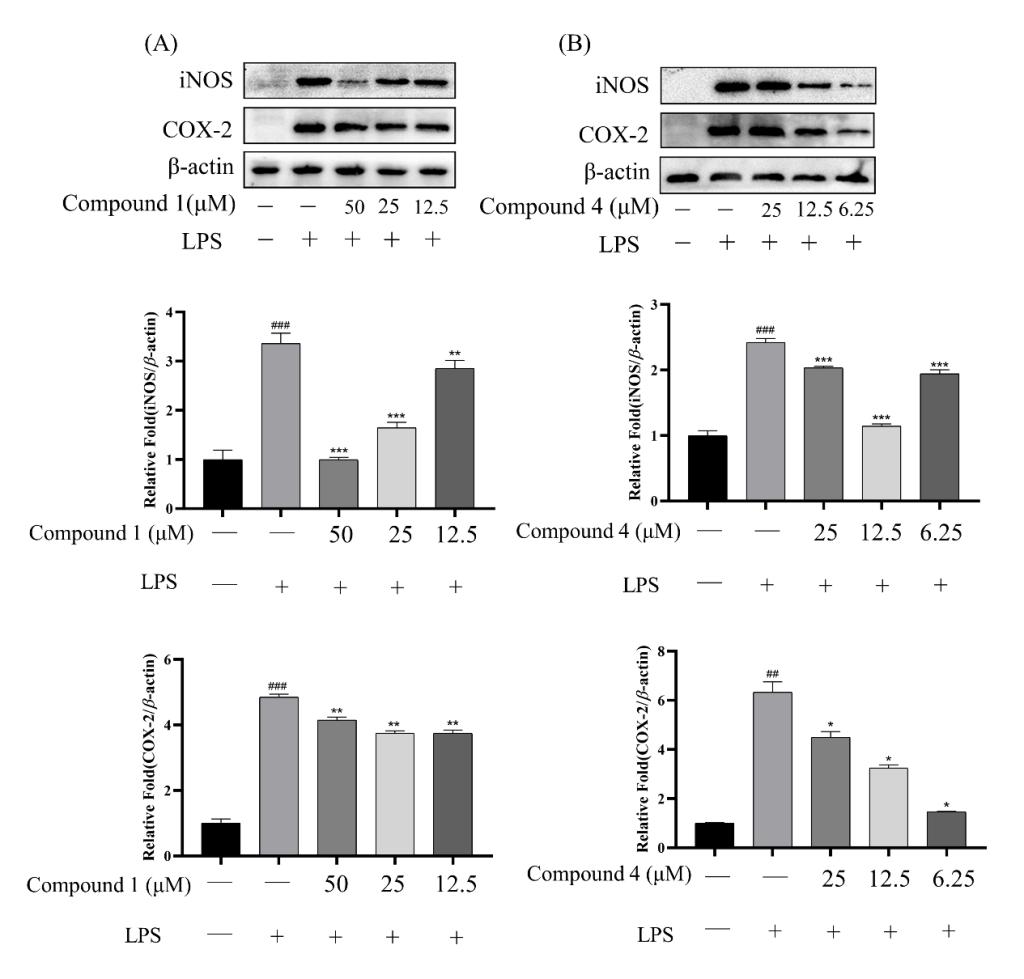
FIGURE 6 | Effects of compound 1 (A) and compound 4 (B) on LPS-induced protein expression of iNOS and COX-2. The data were expressed as mean ± standard deviation, n = 3. Compared with the control, ###P < 0.001, ##P < 0.01. Compared with the LPS group, ***P < 0.001, **P < 0.01, *P < 0.05.
化合物1和化合物4对氧化应激的影响
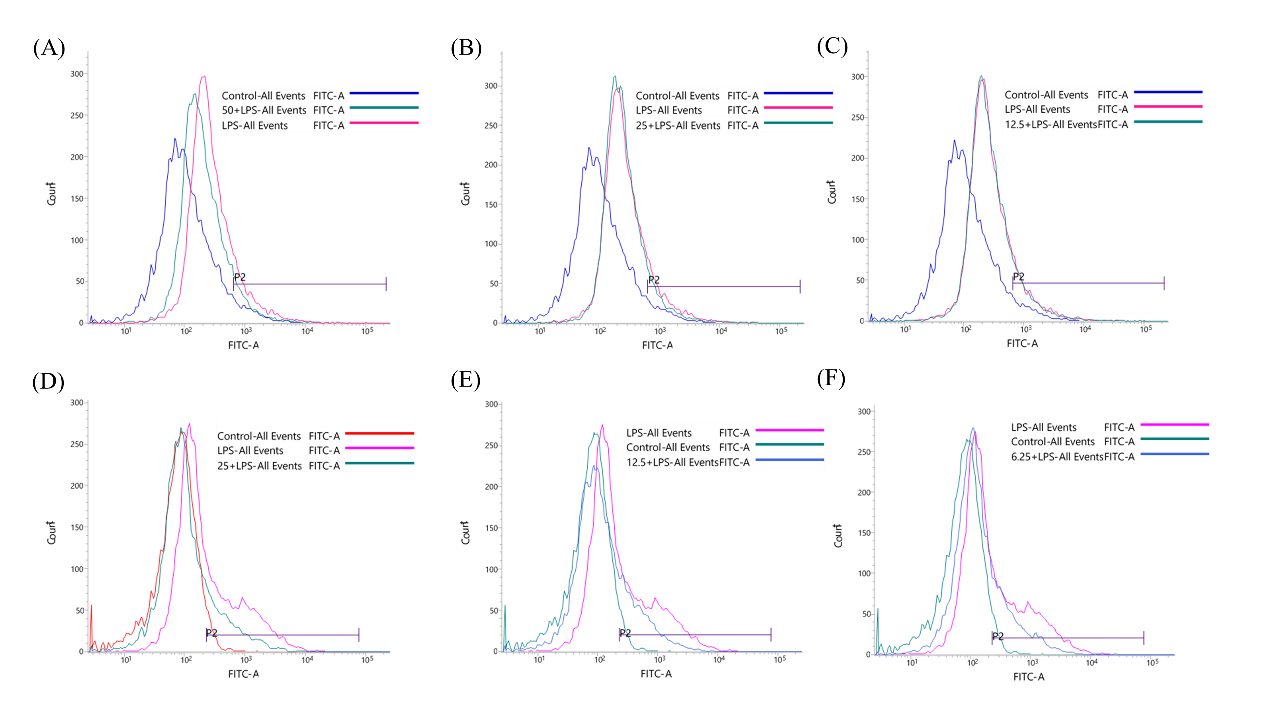
FIGURE 7 | Effects of compound 1 at 50 μM (A), 25 μM (B), 12.5 μM (C) and compound 4 at 25 μM (D), 12.5 μM (E) and 6.25 μM (F) on LPS-induced oxidative stress.
化合物1和化合物4对NF-κB 信号通路的影响
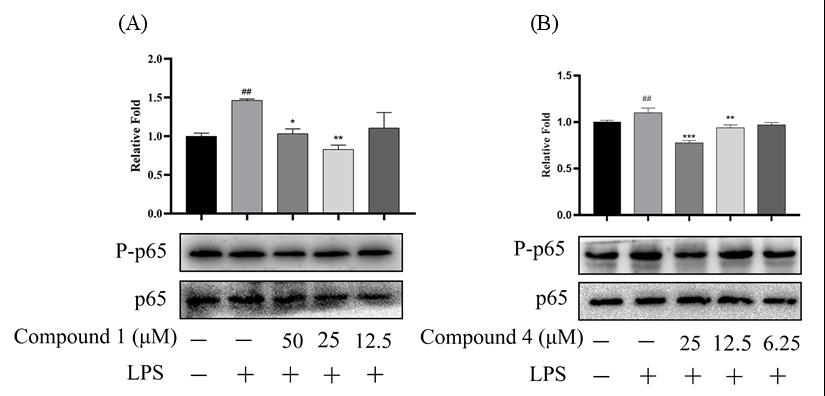
FIGURE 8 | Effects of compound 1 (A) and compound 4 (B) on NF-κB signaling pathway. The data were expressed as mean ± standard deviation, n = 3. Compared with the control, ##P < 0.01. Compared with the LPS group, ***P < 0.001, **P < 0.01, *P < 0.05.
结论:本研究从囊距翠雀花干燥地上部分提取分离得到4个化合物,包括Delbrunine (1), 4-O-α-D-Glucosyl benzoic acid (2), Kaempferol 3-O-β-D-glucopyranoside 7-O-α-L-rhamnopyranoside (3), Eldeline (4)。抗炎活性表明化合物1和化合物4具有较强的抗炎活性。其机制可能与抑制RAW264.7细胞中NF-κB信号通路的激活有关,从而减少炎症因子释放,抑制活性氧的产生,减轻炎症造成的损伤。
Two alkaloids from Delphinium brunonianum Royle, their anti-inflammatory and anti-oxidative stress activity via NF-κB signaling pathway
Qi Tanga1, Sitan Chena1, Syed Arif Hussain Rizvid1, Jiaojiao Qua,b, Li Wanga,b, Senye Wanga,b, Changyang Maa,b,c**, Lijun Liua,e**, Wenyi Kanga,b,c*
aNational R & D Center for Edible Fungus Processing Technology, Henan University, Kaifeng 475004, China
bFunctional Food Engineering Technology Research Center, Henan, Kaifeng, 475004, China
cJoint International Research Laboratory of Food & Medicine Resource Function, Henan Province, Kaifeng 475004, China
dPakistan agricultural research council, Islamabad 450000, Pakistan
e Huaihe Hospital, Henan University, Kaifeng 475004, China
1These authors contributed equally to this work.
**Corresponding authors to: Changyang Ma, Email: macaya1024@vip.henu.edu.cn; Lijun Liu, Tel: 13683781131; Wenyi Kang, E-mail: kangweny@hotmail.com.
ABSTRCT
In this study, we isolated and identified four compounds in Delphinium brunonianum Royle, and they were Delbrunine (1), 4-O-α-D-Glucosyl benzoic acid (2), Kaempferol 3-O-β-D-glucopyranoside 7-O-α-L-rhamnopyranoside (3) and Eldeline (4). Furthermore, the anti-inflammatory activity of these compounds was screened in RAW264.7 cells. The results showed that the anti-inflammatory activity of compound 2 and 3 was weak, and 1, 4 had good anti-inflammatory activity. The macrophage inflammation model was established by lipopolysaccharide (LPS). In this study, the levels of TNF-α and IL-6 were caried by ELISA kits, and the expression of cytokine mRNA was detected by qRT-PCR experiment. Then the effect of the compound 1 and 4 on reactive oxygen species was detected by flow cytometry. Following that, the western blot experiment was used to determine the expression of iNOS, COX-2 and the key proteins in the NF-κB signaling pathway. The results showed that compounds 1, 4 could significantly inhibit the elevation of inflammatory factors nitric oxide (NO), tumor necrosis factor-α (TNF-α), interleukin-6 (IL-6), and also had obvious inhibitory effects on the production of inducible nitric oxide synthase (iNOS) and cyclooxygenase 2 (COX-2). In addition, compounds 1 and 4 could effectively inhibit the overexpression of reactive oxygen species (ROS) in RAW264.7 cells that activated by LPS. These results indicated that compound 1 and 4 may exert anti-inflammatory and anti-oxidative stress effects through the nuclear factor kappa-B (NF-κB) signaling pathway.
Reference: Tang Q, Chen S, Rizvi SA, Qu J, Wang L, Wang S, Ma C, Liu L, and Kang W (2022) Two alkaloids from Delphinium brunonianum Royle, their anti-inflammatory and anti-oxidative stress activity via NF-κB signaling pathway. Front. Nutr.